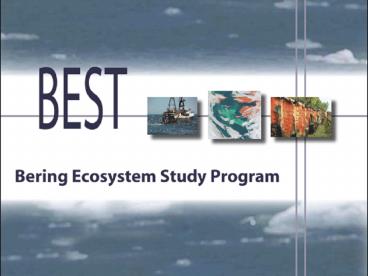P' Stabeno, PMEL - PowerPoint PPT Presentation
1 / 32
Title:
P' Stabeno, PMEL
Description:
Early Ice Retreat Late Bloom, Warm Water Large Copepod Biomass. Late Ice Retreat Early Bloom, Cold Water Small Copepod Biomass. February. March. April ... – PowerPoint PPT presentation
Number of Views:34
Avg rating:3.0/5.0
Title: P' Stabeno, PMEL
1
(No Transcript)
2
The Bering Sea
P. Stabeno, PMEL
3
What is BEST?
- A program designed to understand and predict the
consequences of climate change for Bering Sea
marine ecosystems - End to End Climate, physics, primary production,
zooplankton, fish, seabirds, marine mammals and
people - Strong social sciences component coming on line
4
Why Study the Bering Sea?
- One of worlds most productive regions
- Very rich assemblage of seabirds, marine mammals,
fish, shellfish - Commercial and subsistence economy
- Dutch Harbor 1 - 2 U.S. port landings
- 50 all fish / shellfish landings in U.S.
5
Wind Speed Cubed at St. Paul Is.
P. Stabeno, PMEL
6
The Middle Shelf M2 Mooring
P. Stabeno, PMEL
7
Sea Ice
P. Stabeno, PMEL
8
Changing Climate Bering Sea ice has retreated
over last two decades (1970 - 2002)
Maximum ice extent
Percent ice cover within gray box on map above
P. Stabeno, PMEL
9
Vertically Averaged Temperature (C) at Site M2
P. Stabeno, PMEL
10
M2
1996 2004
M4
P. Stabeno, PMEL
11
Ice, Wind, Bloom, Copepods
Early Ice Retreat Late Bloom, Warm
Water Large Copepod Biomass
Late Ice Retreat Early Bloom, Cold
Water Small Copepod Biomass
G. Hunt, U. Calif. Irvine
12
Emiliania huxleyi cell
13
Bering Sea Coccolithophore Bloom
April 25, 1998 SeaWiFS program
14
Biomass of Medusae in the S.E. Bering Sea
15
Oscillating Control Hypothesis
Cold Regime (Bottom-Up Regulation)
Beginning of Warm Regime (Bottom-Up Regulation)
Warm Regime (Top-Down Regulation)
Beginning of Cold Regime (Both Top-Down and
Bottom-Up Regulation)
Zooplankton
Larval Survival
Abundance of Piscivorous Adult Fish
Juvenile Recruits
16
Fur Seal Pups at the Pribilof Is.
The Bering SeaIs it just a Warmer Barents Sea?
- George L. Hunt, Jr.
- University of California, Irvine
- and
- Bernard Megrey
- NOAA Alaska Fisheries Science Center
NMML, NOAA
17
History of BEST
- Sept. 2002 Laguna Beach, Initial Planning
- Mar. 2003 Seattle, Science Plan Workshop
- Oct. 2004 Science Plan Published
- May 2005 Open Implementation Workshop
- June 2005 Draft Implementation Plan
needed by NSF
18
Laguna Beach Workshop, Sept. 2002
19
Seattle Workshop, Mar. 2003
20
SSC Implementation Teleconferences, Mar. - May
2005
21
BEST Research Priorities
- Primary Focus
- How is the Disappearance of Sea Ice Affecting
the eastern Bering Sea Ecosystem and the people
dependent on it? - Secondary
- a) What Controls the abundance of nutrients
on the - shelf and what is the influence of
climate variability? - b) What will be the ecosystem effects of a
warmer and - more stratified Bering Sea?
- c) Regional studies Northern Bering
Pribilofs Aleutian - Passes
22
BEST Research Priorities
- Focus on the Spring- 1 March to 30 June
- How does climate drive ice conditions?
- How does sea ice affect the type, amount and fate
of primary production? - What controls the biomass of zooplankton in
spring and what role do they play? - How do these bottom-up factors interact with
top-down mechanisms? - What are the expected impacts on upper
trophic-level organisms including people?
23
Implementation Plan- Management
- Interagency Oversight Committee
- Science Steering Committee
- Project Office (once project funded)
- Chief Scientist
- Executive Committee (3-4 people)
- Working Groups as Needed
- (data management, modeling, integration
- outreach, etc)
24
BEST Bering Sea Partners
- NSF
- a) SEARCH NSF-sponsored program on Arctic
Change) - i) Bering Ecosystem Study (BEST)
- NOAA
- a) National Marine Fisheries Service (NMFS)
- b) National Marine Mammal Laboratory (NMML)
- c) Pacific Marine Environmental Laboratory
(PMEL) - d) North Pacific Climate Regimes and Ecosystem
- Productivity Program (NPCREP)
- e) Loss of sea Ice (LOSC) (proposed for IPY)
- North Pacific Research Board (NPRB)
- Alaska Ocean Observing System (AOOS)
- US Fish and Wildlife Service (USFWS)
- US Geological Survey (USGS)
25
Planned NPCREP Moorings and Lines
26
BEST Bering Sea Partners
- International Partners
- North Pacific Anadromous Fish Commission (NPAFC)
- a) Bering Aleutian Salmon International Survey
- (BASIS)
- Census of Marine Life (CoML)
- International Pacific Halibut Commission (IPHC)
- Ecosystem Studies of Sub-Arctic Seas (ESSAS) -
GLOBEC - a) International Polar Year (IPY) programs
27
BEST Time Line
- 2002 Sept. Planning Workshop, Laguna Beach
- 2003 Mar. Planning Workshop, Seattle
- 2004 Oct. Science Plan Published
- 2005 Mar. SSC Formed
- 2005 May. Open Implementation Workshop
- 2005 June. Implementation Plan Ready
- 2005 ? Late Fall. NSF Announcement of Opportunity
- 2006 Proposals Due 90 days later
- 2007 Mar. Begin Field Program
28
BEST Information Sources
- Web Site http//www.arcus.org/Bering/index.html
- Science Plan Available in Hard Copy at
- Arctic Research Consortium of the U.S. (ARCUS)
- 3535 College Road, Suite 101
- Fairbanks, AK 99709
- Phone 907-474-1600 Fax 907-474-1604
- Planning Group c/o George L. Hunt, Jr.
- School of Aquatic Fishery Sciences
- University of Washington
- Email geohunt2_at_u.washington.edu
29
(No Transcript)
30
(No Transcript)
31
Goal of ESSAS
- The goal of the ESSAS Program is to compare,
quantify and predict the impact of climate
variability on the productivity and
sustainability of Sub-Arctic marine ecosystems.
32
Major Research Questions
- How will the External Forcing Functions be
Affected by Climate Change? - How will Changes in the External Forcing
Mechanisms Affect BioPhysical Coupling? - How will Changes in BioPhysical Coupling
Influence Biological Interactions?































